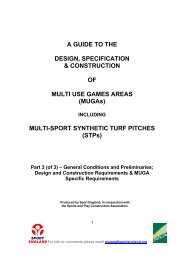View - North East Lincolnshire Council
View - North East Lincolnshire Council
View - North East Lincolnshire Council
You also want an ePaper? Increase the reach of your titles
YUMPU automatically turns print PDFs into web optimized ePapers that Google loves.
BOC Immingham Dissolved Acetylene Project Environmental Statement: Vol. 2 Main Text<br />
17.7 The air quality assessment demonstrated that construction dust emissions are unlikely to affect<br />
sensitive receptors, assuming adherence to good practice measures (which will be defined in the<br />
CEMP). In respect of transport emissions during construction and operation, the projected<br />
changes in traffic flows are insufficient to trigger the need for quantitative assessment of impacts<br />
on air quality (in accordance with the thresholds of the DMRB guidance). Process emissions were<br />
found to be insignificant (i.e. less than 10% of short term and less than 1% of the long term health<br />
and ecological based assessment criteria). Furthermore, process emissions will be managed and<br />
controlled through an ISO14001 and the EA’s permitting regime.<br />
17.8 In summary, impacts on air quality associated with the Project, for both the construction and<br />
operational phases were assessed to be of negligible significance and the Project is considered to<br />
conform to the relevant policy requirements.<br />
Geology, Hydrogeology and Land Quality<br />
Key Policies<br />
17.9 ‘PPS 9 Biodiversity and Geological Conservation’ reflects the requirement for the impact of<br />
development proposals on biodiversity and geological conservation assets to be considered. A list<br />
of geological matters that should be examined includes:<br />
� the baseline geological characteristics and their value;<br />
� the presence of any designated assets and their potential relationship with the proposed<br />
development;<br />
� the potential for development proposals to deliver enhancement to relevant geological<br />
features within the design of the development; and<br />
� any requirements for mitigation of adverse effects, which should be embedded in the<br />
proposals.<br />
17.10 PPS 9 includes a presumption against permitting development that may have an adverse effect<br />
upon a SSSI; and advises that sites of regional and or local geological interest should be<br />
maintained for their contribution to quality of life, research and education.<br />
17.11 PPS 23 advises LPAs to assume that the relevant pollution control regime for a given<br />
development will be properly applied and enforced; thus the primary concern is whether the<br />
Proposed Development is an appropriate use for the site in question. This requires consideration<br />
of whether contamination is present; whether the proposed development will give rise to<br />
contamination and or whether appropriate control measures have been considered; and reviewing<br />
the proposals in the context of potential cumulative effects with other existing or planned<br />
development. The guidance recommends the application of the phased approach of CLR 11 (see<br />
Chapter 7) to the identification of potential impacts upon and effects arising from contamination.<br />
17.12 The ‘Consultation Paper on a New Planning Policy Statement: Planning for a Natural and Healthy<br />
Environment’ outlines proposed planning policy on: biodiversity; geological conservation;<br />
landscape and soil protection; heritage coastline; open space; sport; recreation; green<br />
infrastructure; and floodlighting of sports and recreational facilities. Upon adoption, this document<br />
will replace sections of PPS 23 (amongst other PPSs). Part of the document states that protection<br />
will be given to the best and most versatile (BMV) agricultural land (Grades 1, 2 and 3a), stating<br />
that where significant development of agricultural land is unavoidable, LPAs should seek to<br />
develop areas of poorer quality land (Grades 3b, 4 and 5) in preference to that of higher quality<br />
this updates the current policy (contained in PPS 7) as it adds an exception to this approach<br />
where protecting BMV land would be at variance with other sustainability considerations.<br />
5100935.404 Environmental Statement August 2011 286




